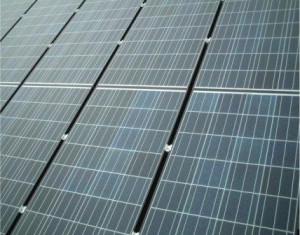Electron spin may hold key to better solar cells
 Silicon is usually preferred for making solar cells because of the large industrial base the element has and also because of its easy availability. Silicon has 14 electrons, arranged in three different shells. The first two shells are full while the outer shell is half full with four electrons. A silicon atom in order to fill up its last orbit looks to share electrons with four nearby atoms.
Silicon is usually preferred for making solar cells because of the large industrial base the element has and also because of its easy availability. Silicon has 14 electrons, arranged in three different shells. The first two shells are full while the outer shell is half full with four electrons. A silicon atom in order to fill up its last orbit looks to share electrons with four nearby atoms.
With energy addition in silicon, like heat, it can cause some electrons to break free of their bonds and leave their atoms. A hole is left behind. These electrons also known as free carriers wander around looking for another hole to fall into and in the process carry what is called an electrical current. Impure silicon takes a lot less energy to knock loose one of the “extra” phosphorous electrons because they aren’t bonded with any neighbouring atoms. Most of these electrons break free and we have a lot more free carriers than we would have in pure silicon. The process of adding impurities on purpose is called doping.
A new class of solar cells that are known as organic solar cells and mimic photosynthesis have the potential to bring about a revolution in how we use solar energy. Currently, their efficiency is very low, only 12% which is about half of what silicon based cells achieve.
However researchers from the Universities of Cambridge and Washington, have discovered that once the spin of these electrons is manipulated, then the solar cell has increased efficiency. Findings have been published in the journal Nature.
As stated on the website of University of Cambridge-
Researchers from Cambridge’s Cavendish Laboratory developed sensitive laser-based techniques to track the motion and interaction of electrons in these cells. To their surprise, the team found that the performance differences between materials could be attributed to the quantum property of ‘spin’.
Researchers found that by arranging the electrons ‘spin’ in a specific way, they can block the energy collapse from ‘recombination’ and increase current from the cell.
“This discovery is very exciting, as we can now harness spin physics to improve solar cells, something we had previously not thought possible. We should see new materials and solar cells that make use of this very soon” said Dr. Akshay Rao, a Research Fellow at the Cavendish Laboratory and Corpus Christi College, Cambridge, who lead the study with colleagues Philip Chow and Dr. Simon Gélinas.”
This may ultimately lead the way towards designing cheaper, more efficient solar cells.
Reference and further reading;

